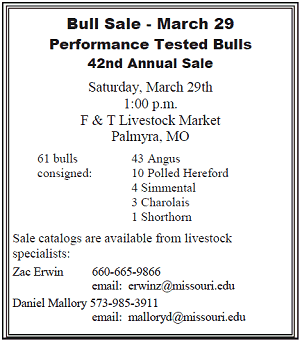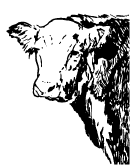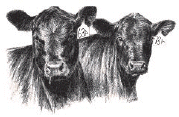

To send a message to an author, click on the author's name at the end of the article.
This Month in Ag Connection | Ag Connection - Other Issues Online
On February 7, President Obama signed the Agricultural Act of 2014, more commonly known as the farm bill. This bill contains a projected $956 billion in spending over the next 10 years. This amount is approximately 50 percent more than the 2008 Farm Bill. The bill was heavily debated and several changes were made from the previous Farm Bill. The following is a summary of the commodities, conservation, nutrition, and crop insurance provisions of the bill.
Title 1 - Commodities
The bill repeals direct payments and counter
cyclical payments. The average crop revenue election (ACRE) program is also
repealed, but does continue through the 2013 crop year.

This Farm Bill gives farmers two options via a one-time irrevocable election with respect to programs designed to replace the ACRE program and direct payments - Agricultural Risk Coverage (ARC) and Price Loss Coverage (PLC). The election can be made on a crop-by-crop basis. If an election is not made for a farm, a default rule applies PLC to the farm. PLC payments are triggered if U.S. average market price for the crop year are less than the crop's reference price. Examples of reference prices are $5.50/bushel for wheat, $3.70/bushel for corn and $8.40/bushel for soybeans. ARC payments are triggered when actual crop revenue is less than the ARC revenue guarantee for the crop year. The county ARC guarantee is pegged at 86 percent of the county ARC benchmark revenue, with coverage capped at 10 percent. This makes coverage between 76 percent and 86 percent of the county ARC benchmark revenue. Benchmark revenue is tied to the Olympic average which takes the average prices for the five immediately preceding crop years without the high and low yields. ARC is based on the entire farm and not an individual crop. For, both PLC and ARC, payment acres are pegged at 85 percent of the farm's base acres for the crop at issue. Individual ARC payments are 65 percent of a farm's total base acres.
The bill replaces the Dairy Product Price Support and MILC programs with the Dairy Production Margin Protection Program effective September 1, 2014. The program is based on the difference between the price of milk and the feed cost of producing milk. A coverage level can be elected in a range between $4 and $8 per cwt in $.50 increments. There is no premium for the lowest level of coverage.
Payment limitations, or the total amount of payments an individual or entity can receive either directly or indirectly (except for a joint venture or general partnership), for any crop year is $125,000. Spouses are able to double that amount. Within 180 days of enactment, the USDA Secretary is to write regulations defining the term "significant contribution of active personal management" and perhaps set limits for various types of farming operations based on the number of individuals who can be considered to be actively engaged in farming. But, the regulations are not to apply to entities comprised solely of family members.
The bill removes both the farm and non-farm adjusted gross income (AGI) limitations of the 2008 Farm Bill and replaces them with a $900,000 AGI limitation applicable to any individual or entity. The $900,000 AGI limitation applies to both commodity and conservation programs.
Title II - Conservation
The 2014 Farm Bill repeals the Grassland
Reserve Program, Agricultural Water Enhancement Program, and the Wildlife
Habitat Incentive program. The bill extends the Conservation Reserve Program
(CRP) through 2018, and the maximum acreage that can be enrolled in the CRP
drops from 27.5 million acres in fiscal year 2014 to 24 million acres in 2018.
Of those amounts, a limit of 2 million acres of grasslands is imposed for all
years. The bill reduces the amount of acres eligible for the farmable wetland
program from 1 million acres to 750,000 acres. An enrollment cap of 10,000,000
acres in the Conservation Stewardship Program (CSP) is set at an enrollment rate
of $18/acre through 2022. The Environmental Quality Incentives Program (EQIP) is
extended, but a $450,000 payment limit is established for contracts entered into
through 2018. The bill establishes an agricultural conservation easement
program. Land eligible for the program includes land that was formerly enrolled
in the Wetlands Reserve Program and the Farmland Protection and Farm Viability
Program (which are repealed). The bill requires conservation compliance for a
producer to be eligible for crop insurance premium assistance on highly erodible
land and wetland.
Title IV - Nutrition
An estimated 80 percent of spending under the
bill is attributed to Food Stamps - referred to as the Supplemental Nutrition
Assistance Program (SNAP). Since fiscal year 2000, food stamp spending has
quadrupled, and it has doubled since the beginning of 2009. This bill reduces
Food Stamp spending by approximately $8 billion. That represents a cut of
approximately 1 percent. The bill does not contain any limitation on assets for
Food Stamp recipients. Thus, individuals can own unlimited assets (under a
policy known as "broad-based categorical eligibility") and still qualify for
Food Stamps if their income is below specified levels.
Title XI - Crop Insurance
The bill provides a Supplemental
Coverage Option which allows a producer the option to buy county-level insurance
to cover part of the deductible under the farmer's individual yield and revenue
loss policy. Under the provision, the coverage level cannot exceed 85 percent of
the individual yield or 95 percent of the area yield. The Supplemental Coverage
Option is triggered only if the losses in the area exceed 14 percent of normal
levels. The bill establishes a revenue-minus-cost margin crop insurance contract
via an amendment to the Federal Crop Insurance Act. These are just a few
highlights from the new legislation. More information will be shared in the
months ahead as tools are developed to help farmers make decisions.
Source: Karisha Devlin, Ag Business Specialist
This Month in Ag Connection | Ag Connection - Other Issues Online

Data from Northeast Missouri (NEMO) Beef Cattle Improvement Association (BCIA) Performance Tested Bull Sales has been compiled over the past several years. The data has been used to track and compare sale prices to measurable traits and performance figures to determine differences in bull sale prices. The following are those traits shown to effect sale price:
These observations were determined from data collected from bull buyers at one particular sale. The next bull sale will be March 29th in Palmyra, MO.
Source: Zac Erwin, Livestock Specialist
This Month in Ag Connection | Ag Connection - Other Issues Online

In a final guidance, the Federal Drug Administration (FDA) lays out a road map for animal pharmaceutical companies to voluntarily revise the FDA-approved use conditions on the labels of these products to remove production indications. The plan also calls for changing the current over-the-counter (OTC) status to bring the remaining appropriate therapeutic uses under veterinary oversight. Once a manufacturer voluntarily makes these changes, its medically important antimicrobial drugs can no longer be used for production purposes, and their use to treat, control, or prevent disease in animals will require veterinary oversight.
To help veterinarians and producers of food-producing animals comply with the new terms of use for these products once the recommended changes are implemented, FDA is proposing changes to the Veterinary Feed Directives (VFD) process. This is an existing system governs the distribution and use of certain drugs (VFD drugs) that can only be used in animal feed with the specific authorization of a licensed veterinarian. Feed-use antibiotics that are considered medically important and are currently available as OTC products will, come under the VFD process based on the guidance document.
Source: Zac Erwin, Livestock Specialist
This Month in Ag Connection | Ag Connection - Other Issues Online
The Northeast Missouri Show-Me-Select Replacement heifer sale reached a record sale average of $2,177 held at F & T Livestock Auction, in Palmyra, MO on December 14, 2013. Twenty-one producers of the 275 heifers enrolled in the University of Missouri Extension educational heifer management program. The heifers were bred to sires with both calving-ease and growth genetics. The sale average was $80 per head higher than the previous year at Palmyra. The top lot sold belonged to Jim and Sharon Schlager and brought $4,200.
Highest average price from a consignor was $2,831 for 8 head from Jim and Sharon Schlager. Other top consignors were Keithley/Jackson Farms, Frankford, Mo., $2,707 on 22 head; Chris Scheiffer, Troy, Mo., $2,375 on 5 head; Dan Moore, Kahoka, Mo. $2,364 on 11 head; Gene Dryden, Hannibal, Mo. $2,344 on 9 head. Forty-three buyers were responsible for just under $600,000 worth of bred heifer exchanging hands. 30 repeat buyerspurchased 178 head, or 65 percent of the total consignment. Calving surveys returned by these buyers provide important information that is given back to consignors to improve for future years.
The Show-Me-Select heifer development program is a yearlong process. Heifers complete a pre-breeding examination 4 to 8 weeks before to breeding. The exam includes a pelvic measurement, reproductive tract score, and weight. Heifers may be bred by artificial insemination (AI) or be exposed to natural service (service sires must meet specific calving ease EPD requirements based on breed). This year 189 head, or 69 percent, of the heifers in the sale were synchronized and bred AI. In this sale, the choice to AI, showed a $278 price advantage over those bred naturally.

All heifers must be pregnancy tested within 90 days of breeding by a veterinarian to determine expected calving date. The use of ultrasound has helped many of the veterinarians improve their accuracies on calving dates. During the development period the heifers undergo an extensive health program and are vaccinated at weaning, pre-breeding, and pregnancy examination as well as treated several times for internal and external parasites. Heifers are also screened for blemishes, condition, muscling and structural soundness by a University of Missouri Extension livestock specialist and USDA graders.
For more information on the Show-Me Select program contact your local University of Missouri Extension Livestock Specialist.
Source: Daniel Mallory, Livestock Specialist
This Month in Ag Connection | Ag Connection - Other Issues Online
In northern Missouri late February to early March is generally the best time to frost seed legumes into pas-tures. Weather, such as deep snow followed by pro-longed cold, may interfere. Here is some advice from the Missouri Grazing Manual, courtesy of the MU For-age Systems Research Center, that may help as you plan around weather to get legumes seeded into estab-lished pastures.
The limiting factor regarding what species can be suc-cessfully frost seeded is tolerance to cold weather while in the seedling stage. Red and white clover can be frost seeded with very consistent success due to their high seedling vigor and frost tolerance in the seedling stage. Although quite susceptible to freezing in the cotyledon stage, these clover species become very hardy after the emergence of the first trifoliate leaf. Alfalfa and birdsfoot trefoil are less tolerant of cold temperatures in the seedling stage and are thus more susceptible to stand failure when frost seeded. Seedling vigor is also somewhat lower than for red clo-ver and both alfalfa and birdsfoot trefoil are much less shade tolerant than is red clover.
Most successful frost seeding will occur if seed is broadcast late February through early March in north Missouri. The seed must come in contact with the soil for frost seeding to be effective. For this reason compe-tition from established forages and weeds must be con-trolled. Spring grazing will allow some of the seed to be trampled into the soil, if soil moisture is not exces- sive. If chemical suppression of the sod is to be used, it should be done the previous fall. Waiting until spring when green growth has begun to apply herbicides makes frost seeding much less effective.
Pasture burning to retard cool-season grass growth in the spring generally occurs too late as legume seed-lings should already be up and growing by the opti-mum fire date. However, broadcast seeding immedi-ately into the ash bed following a spring burn has been reported to work with adequate rainfall after seeding. Sod disturbance combined with frost seeding works quite well as the roughened soil surface is more condu-cive to good seed-soil contact due to freezing-thawing activity. If pastures are to be harrowed for manure dis- persion, broadcast seeding at the same time often gives better results than simply frost seeding, particularly with birdsfoot trefoil and alfalfa. If a harrow is used,
seeding is usually delayed until later in the spring after the risk of late frost is lessened. The success rate is generally high if slight sod disturbance is combined with broadcast seeding and harrowing in spring.
For more information on frost seeding legumes into pasture visit extension.missouri.edu, click agricul-ture, crops, forages and select the publication for the legume you are interested in seeding.
Source: Max Glover, Agronomy Specialist
Publishing Information
Ag Connection is published monthly for Northeast and Central areas of Missouri producers and is supported by the University of Missouri Extension, the Missouri Agricultural Experiment Station, and the MU College of Agriculture, Food and Natural Resources. Managing Editor: Mary Sobba.